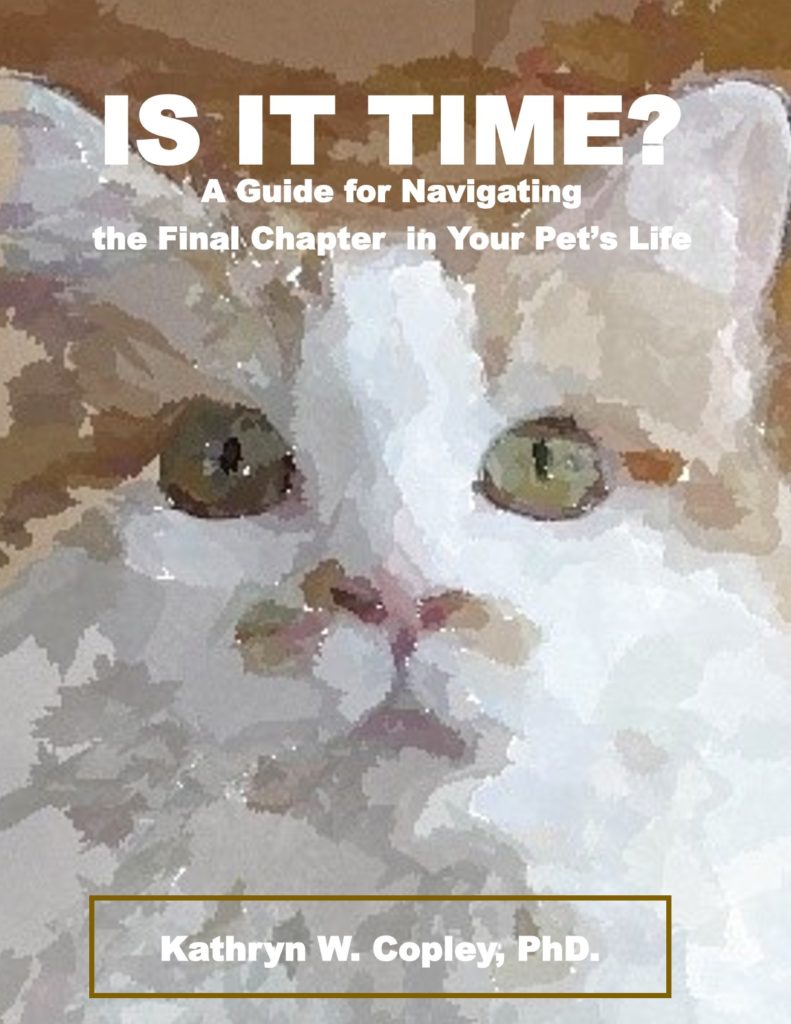If animals could speak, the dog would be a blundering outspoken fellow, but the cat would never say a word too much. — Mark Twain
THREE
QUALITY OF LIFE SCALES
Used with permission from Dr. Katie Hilst copyright 2013
Used with permission from Dr. Alice Villalobos
Additional resource
Quality of Life questionnaire | Transitions Veterinary Services | San Diego
See WAYS TO MAKE YOUR PET MORE COMFORTABLE for ways to improve quality of life.

The normal signs of aging represent a quality of life change, but they can also initiate new pleasures – sleeping in the sun, more car rides, more lap time. RUFFIAN, who owned Drew
HOW LONG MIGHT YOUR PET LIVE?
Cats living to 16, 18 or even 20 years are no longer rarities. Dogs’ lifespans are influenced a lot by size, with smaller dogs generally living longer. Click here for more in-depth information on what influences a dog’s longevity.
In both species, spayed/neutered animals tend to live longer than intact ones.
QUALITY OF LIFE -- YOURS AND YOUR PET'S
The sad truth is that as pets live longer because of nutritional and medical advances, high quality of life may not accompany the additional years.
Cats like to keep themselves clean. They like “clean” so much that they keep each other clean. So, a cat that is unable to groom itself is experiencing diminished quality of life. A dog that is no longer able to enjoy a romp with a tennis ball because of fatigue or a limp is also experiencing diminished quality of life. Some of these diminishments are part of the normal aging process and are replaced with new things to enjoy – sleeping in the sun, car rides, curling up in a lap.
Whatever the cause or degree, quality of life changes are worth looking at and their potential relationship to pain is worth investigating.
Pain’s influence on quality of life
Many elements of assessing quality of life are the same as for assessing pain because often it is pain that interferes with the energy or mobility that are hallmarks of quality of life. Pain changes both your pet’s ability and desire to engage in pleasurable activities like walks or chasing a twirling feather. Quality of life scales help assess how pain is influencing quality of life in the moment as well as over time.
Was Scout able to take a brisk walk last month but is unable to do so now? Was he unable to do so last month but pain medicine or other treatment has made it possible for him to enjoy that brisk walk once again? Assessing quality of life in the run-up to deciding about surgery, for example, and assessing it again after the treatment has its effect provide your veterinarian with valuable information.
Neither the presence of pain nor its absence is sufficient to determine whether your pet is having a good life.
Perhaps your dog that previously had pretty much your constant company now spends most of the day outside because you have gone back to work or become caregiver to a sick parent or child. Your new baby or partner changes the dynamic between you and your pet as well.
Whether pain is the cause of the quality-of-life change or the change is for some other reason, quality of life is always worth looking into.
Uses for quality of life scales
Numerous organizations have developed quality of life scales to quantify what you are observing about your aging or ailing pet. They have multiple uses:
- To assist you in describing your pet’s situation to your veterinarian.
- To identify the areas/activities in your pet’s life that have diminished so they can be addressed.
- As a benchmark from which to track improvement or decline.
- To track change over time. A simple way to use a quality of life scale to track change is to use the scale periodically, like once a week or every two weeks, using a different colored pen — keyed to the date — to distinguish one date from another.
- Especially for pets in hospice care, to determine whether changes in the treatment plan are called for.
- To help answer the question Is it time? It is the quality of your pet’s life, not its quantity, that should be the deciding factor. That we can prolong life doesn’t always mean we should.
Many scales give a numeric value to each item, suggesting that you add the numbers and use the total as a decision-making tool. For when that approach misses the nuances of your pet’s situation, the verbal descriptors are still valuable in making sure you don’t miss something important when you evaluate the situation or talk to your vet.
When your pet’s situation affects your quality of life
Your quality of life is also at issue because the decline in your pet’s health affects your life as well as his. There are many sources of uncertainty and, therefore, stress:
Medical — Is there a diagnosis? If not, what will it cost and what will your pet go through to get one? Can the condition be treated, and should it be? Is the prognosis a plateau? A long slow decline? A slow decline followed by a precipitous descent?
Personal — Do you have the emotional and financial resources to handle what the future may bring? If you don’t, what could you do to get them, for both your pet’s sake and your own?
Interpersonal – Is everyone who loves this pet on the same page on how to approach what may be its final journey?
If only our pets could unmistakably communicate their needs. Understanding your pet’s quality of life can help you make decisions about how best to provide comfort in what may be your pet’s last chapter.

All the named animals pictured in this blog were someone’s treasured pet. They may have crossed the Rainbow Bridge, but their absence makes them no less beloved.


I may not know what tomorrow will bring, but today I have you.


